Assessment of Multiple Ecosystem Services and Ecological Security Pattern in Shanxi Province, China
Abstract
1. Introduction
2. Materials and Methods
2.1. Study Area
2.2. Data Sources
2.3. Methods
2.3.1. Ecosystem Service Estimation
2.3.2. Multiple Ecosystem Services Landscape Index (MESLI)
2.3.3. Hotspot Analysis
2.3.4. Ecological Security Pattern Construction
3. Results
3.1. Spatial Pattern of Ecosystem Services
3.2. Spatial Distribution of MESLI
3.3. Hotspot Analysis of Ecosystem Services and Spatial Distribution of Ecological Sources
3.4. Construction of Ecological Security Pattern
4. Discussion
4.1. Ecological Corridors Optimization
4.2. Planning Strategies under the Ecological Security Pattern
4.3. Limitations and Prospects
5. Conclusions
Supplementary Materials
Author Contributions
Funding
Institutional Review Board Statement
Informed Consent Statement
Data Availability Statement
Conflicts of Interest
References
- Millennium Ecosystem Assessment. Ecosystems and Human Well-Being: Biodiversity Synthesis; Island Press: Washington, DC, USA, 2005. [Google Scholar]
- Zhou, S.; Peng, L. Integrating a mixed-cell cellular automata model and Bayesian belief network for ecosystem services optimization to guide ecological restoration and conservation. Land Degrad. Dev. 2022, 33, 1579–1595. [Google Scholar] [CrossRef]
- Bai, Y.; Wong, C.P.; Jiang, B.; Hughes, A.C.; Wang, M.; Wang, Q. Developing China’s Ecological Redline Policy using ecosystem services assessments for land use planning. Nat. Commun. 2018, 9, 3034. [Google Scholar] [CrossRef]
- Yuan, M.H.; Lo, S.L. Ecosystem services and sustainable development: Perspectives from the food-energy-water Nexus. Ecosyst. Serv. 2020, 46, 101217. [Google Scholar] [CrossRef]
- Hossain, M.S.; Dearing, J.A.; Rahman, M.M.; Salehin, M. Recent changes in ecosystem services and human well-being in the Bangladesh coastal zone. Reg. Environ. Chang. 2016, 16, 429–443. [Google Scholar] [CrossRef]
- Sun, X.; Yang, P.; Tao, Y.; Bian, H.Y. Improving ecosystem services supply provides insights for sustainable landscape planning: A case study in Beijing, China. Sci. Total Environ. 2020, 802, 149849. [Google Scholar] [CrossRef] [PubMed]
- Costanza, R.; d’Arge, R.; Groot, R.D.; Farber, S.; Grasso, M.; Hannon, B.; Limburg, K.; Naeem, S.; O’Neill, R.V.; Paruelo, J.; et al. The value of the world’s ecosystem services and natural capital. Nature 1997, 387, 253–260. [Google Scholar] [CrossRef]
- Jiang, W.G.; Deng, Y.; Tang, Z.H.; Lei, X.; Chen, Z. Modelling the potential impacts of urban ecosystem changes on carbon storage under different scenarios by linking the CLUE-S and the InVEST models. Ecol. Model. 2017, 345, 30–40. [Google Scholar] [CrossRef]
- Aneseyee, A.B.; Elias, E.; Soromessa, T.; Feyisa, G.L. Land use/land cover change effect on soil erosion and sediment delivery in the Winike watershed, Omo Gibe Basin, Ethiopia. Sci. Total Environ. 2020, 728, 138776. [Google Scholar] [CrossRef]
- Gong, J.; Cao, E.; Xie, Y.C.; Xu, C.X.; Li, H.Y.; Yan, L.L. Integrating ecosystem services and landscape ecological risk into adaptive management: Insights from a western mountain-basin area, China. J. Environ. Manag. 2020, 281, 111817. [Google Scholar] [CrossRef]
- Fang, Z.; Ding, T.H.; Chen, J.Y.; Xue, S.; Zhou, Q.; Wang, Y.X.; Huang, Z.D.; Yang, S.L. Impacts of land use/land cover changes on ecosystem services in ecologically fragile regions. Sci. Total Environ. 2022, 831, 154967. [Google Scholar] [CrossRef]
- Cong, W.C.; Sun, X.Y.; Guo, H.W.; Shan, R.F. Comparison of the SWAT and InVEST models to determine hydrological ecosystem service spatial patterns, priorities and trade-offs in a complex basin. Ecol. Indic. 2020, 112, 106089. [Google Scholar] [CrossRef]
- Wu, J.G. Urban ecology and sustainability: The state-of-the-science and future directions. Landsc. Urban Plan. 2014, 125, 209–221. [Google Scholar] [CrossRef]
- Peng, J.; Zhao, H.J.; Liu, Y.X.; Wu, J.S. Research progress and prospect on regional ecological security pattern construction. Geogr. Res. 2017, 36, 407–419. [Google Scholar] [CrossRef]
- Harvey, E.; Gounand, I.; Ward, C.L.; Altermatt, F. Bridging ecology and conservation: From ecological networks to ecosystem function. J. Appl. Ecol. 2017, 54, 371–379. [Google Scholar] [CrossRef]
- Chen, J.; Wang, S.S.; Zou, Y.T. Construction of an ecological security pattern based on ecosystem sensitivity and the importance of ecological services: A case study of the Guanzhong Plain urban agglomeration, China. Ecol. Indic. 2022, 136, 108688. [Google Scholar] [CrossRef]
- Yu, K.J. Landscape ecological security patterns in biological conservation. Acta Ecol. Sin. 1999, 19, 8–15. [Google Scholar] [CrossRef]
- Dong, J.Q.; Peng, J.; Xu, Z.H.; Liu, Y.X.; Wang, X.Y.; Li, B. Integrating regional and interregional approaches to identify ecological security patterns. Landsc. Ecol. 2021, 36, 2151–2164. [Google Scholar] [CrossRef]
- Dai, L.; Liu, Y.B.; Luo, X.Y. Integrating the MCR and DOI models to construct an ecological security network for the urban agglomeration around Poyang Lake, China. Sci. Total Environ. 2021, 754, 141868. [Google Scholar] [CrossRef] [PubMed]
- Wang, S.; Li, W.J.; Li, Q.; Wang, J.F. Ecological security pattern construction in Beijing-Tianjin-Hebei region based on hotspots of multiple ecosystem services. Sustainability 2022, 14, 699. [Google Scholar] [CrossRef]
- Ye, X.; Zou, C.X.; Liu, G.H.; Lin, N.F.; Xu, M.J. Main research contents and advances in the ecological security pattern. Acta Ecol. Sin. 2018, 38, 3382–3392. [Google Scholar] [CrossRef]
- Gao, M.W.; Hu, Y.C.; Bai, Y.P. Construction of ecological security pattern in national land space from the perspective of the community of life in mountain, water, forest, field, lake and grass: A case study in Guangxi Hechi, China. Ecol. Indic. 2022, 139, 108867. [Google Scholar] [CrossRef]
- Yang, S.S.; Zou, C.X.; Shen, W.S.; Shen, R.P.; Xu, D.L. Construction of ecological security patterns based on ecological red line: A case study of Jiangxi Province. Chin. J. Ecol. 2016, 35, 250–258. [Google Scholar] [CrossRef]
- Wang, X.R.; Wan, R.R.; Pan, P.P. Construction and adjustment of ecological security pattern based on MSPA-MCR Model in Taihu Lake Basin. Acta Ecol. Sin. 2022, 42, 1968–1980. [Google Scholar] [CrossRef]
- Zhang, Q.; Wang, G.; Yuan, R.Y.; Singh, V.P.; Wu, W.H.; Wang, D.Z. Dynamic responses of ecological vulnerability to land cover shifts over the Yellow river Basin, China. Ecol. Indic. 2022, 144, 109554. [Google Scholar] [CrossRef]
- Zhang, Y.H.; Wang, Z.; Hu, S.G.; Song, Z.Y.; Cui, X.G.; Afriyie, D. Spatial and Temporal Evolution and Prediction of the Coordination Level of “Production-Living-Ecological” Function Coupling in the Yellow River Basin, China. Int. J. Environ. Res. Public Health 2022, 19, 14530. [Google Scholar] [CrossRef]
- Omer, A.; Ma, Z.G.; Yuan, X.; Zheng, Z.Y.; Saleem, F. A hydrological perspective on drought risk-assessment in the Yellow River Basin under future anthropogenic activities. J. Environ. Manag. 2021, 289, 112429. [Google Scholar] [CrossRef]
- Ning, T.; Guo, X.Y.; Rong, Y.J.; Du, S.X.; Li, C. Evaluation of soil conservation function importance of ecosystems in Shanxi Province based on RUSLE model. Bull. Soil Water Conserv. 2019, 39, 205–210. [Google Scholar] [CrossRef]
- Hao, X.J.; Zhang, H.; Xu, X.M.; Wang, L.; Cui, Y. Evolution and simulation of land use/land cover pattern in northern Shanxi Province. Acta Ecol. Sin. 2020, 40, 257–265. [Google Scholar] [CrossRef]
- Zhu, C.C.; Gong, J.R.; Yang, B.; Zhang, Z.H.; Wang, B.; Shi, J.Y.; Yue, K.X.; Zhang, W.Y. Changes of windbreak and sand fixation services and the driving factors in the desert steppe, Inner Mongolia. Acta Ecol. Sin. 2021, 41, 4606–4617. [Google Scholar] [CrossRef]
- Ma, Y.J.; Su, Z.Z. Study on sandy desertification of present situation and development trend in Shanxi province. J. Soil Water Conserv. 2003, 6, 81–84. [Google Scholar] [CrossRef]
- Yang, Y.H.; Shi, Y.; Sun, W.J.; Chang, J.F.; Zhu, J.X.; Chen, L.Y.; Wang, X.; Guo, Y.P.; Zhang, H.T.; Yu, L.F.; et al. Terrestrial carbon sinks in China and around the world and their contribution to carbon neutrality. Sci. China Life Sci. 2022, 65, 861–895. [Google Scholar] [CrossRef]
- Zhou, P.; Hou, H.L.; Zhang, H.; Liu, X.J.; Tan, W.B. The development prospects and implementation suggestions of increasing soil carbon storage in the context of carbon neutrality. Environ. Prot. 2021, 49, 63–67. [Google Scholar] [CrossRef]
- Ahmed, N.; Ahmad, M.; Ahmed, M. Combined role of industrialization and urbanization in determining carbon neutrality: Empirical story of Pakistan. Environ. Sci. Pollut. Res. Int. 2021, 29, 15551–15563. [Google Scholar] [CrossRef] [PubMed]
- Yang, Y.P.; Chen, J.J.; Ren, J.H.; Feng, Z.H.; Zhou, G.Q.; You, H.T.; Han, X.W. Construction of ecological security pattern based on the importance of ecological protection—A case study of Guangxi, a karst region in China. Int. J. Environ. Res. Public Health 2022, 19, 5699. [Google Scholar] [CrossRef]
- Kang, Q.; Guo, Q.X.; Ding, Y.; Zhang, Y.; Hu, Y.; Chen, S.Y. Temporal and spatial evolution ang driving factors of productional-living-ecological functions of Shanxi Province during 2005–2018. Bull. Soil Water Conserv. 2021, 41, 327–337. [Google Scholar] [CrossRef]
- Han, R.; Zhang, J.J.; Zhu, W.B.; Wang, L.Y.; Zhang, L.J.; Zhu, L.Q. Impact of land use change on habitat in the Qihe River Basin of Taihang Mountains. Prog. Geogr. 2018, 37, 1693–1704. [Google Scholar] [CrossRef]
- He, J.; Shi, X.Y.; Fu, Y.J. Optimization of ecological security pattern in the source area of Fen River Basin based on ecosystem services. J. Nat. Resour. 2020, 35, 814–825. [Google Scholar] [CrossRef]
- Zhao, Q.K.; Wang, Z.G.; Zhang, G.C.; Zhang, C.; Hu, X.L.; Zhang, S.Y. Assessment of eco-environment vulnerability in functional regions of soil and water conservation in Shanxi Province. Sci. Soil Water Conserv. 2014, 12, 16–22. [Google Scholar] [CrossRef]
- Hu, W.; Li, G.; Li, Z. Spatial and temporal evolution characteristics of the water conservation function and its driving factors in regional lake wetlands—Two types of homogeneous lakes as examples. Ecol. Indic. 2021, 130, 108069. [Google Scholar] [CrossRef]
- Gu, Y.Y.; Lin, N.F.; Ye, X.; Xu, M.J.; Qiu, J.; Zhang, K.; Zou, C.X.; Qiao, X.N.; Xu, D.L. Assessing the impacts of human disturbance on ecosystem services under multiple scenarios in karst areas of China: Insight from ecological conservation red lines effectiveness. Ecol. Indic. 2022, 142, 109202. [Google Scholar] [CrossRef]
- Liu, M.Z.; Zhang, H.J.; Ren, H.Y.; Pei, H.W. Spatiotemporal Variations of the Soil Conservation in the Agro-pastoral Ecotone of Northern China under Grain for Green Program. Res. Soil Water Conserv. 2021, 28, 172–178. [Google Scholar] [CrossRef]
- Yu, B.L.; Wu, W.J.; Zhao, X.J.; Wu, E.T.; Cai, L.Y.; Yang, F.J. Benefits of soil wind erosion control of the Beijing-Tianjin Sand Source Control Project in Inner Mongolia. Arid Zone Res. 2016, 33, 1278–1286. [Google Scholar] [CrossRef]
- Deng, Y.J.; Yao, S.B.; Hou, M.Y.; Zhang, T.Y.; Lu, Y.N.; Gong, Z.W.; Wang, Y.F. Assessing the effects of the Green for Grain Program on ecosystem carbon storage service by linking the InVEST and FLUS models: A case study of Zichang county in hilly and gully region of Loess Plateau. J. Nat. Resour. 2020, 35, 826–844. [Google Scholar] [CrossRef]
- Tang, L.P.; Ke, X.L.; Zhou, T.; Zheng, W.W.; Wang, L.Y. Impacts of cropland expansion on carbon storage: A case study in Hubei, China. J. Environ. Manag. 2020, 265, 110515. [Google Scholar] [CrossRef]
- Dai, L.D.; Zhang, Y.L.; Ding, R.J.; Yan, Y.G. Spatiotemporal Distribution and Influencing Factors of the Net Primary Productivity in the Datai Mine in Western Beijing. Sustainability 2022, 14, 15567. [Google Scholar] [CrossRef]
- Gong, J.; Xie, Y.; Cao, E.; Huang, Q.Y.; Li, H.Y. Integration of InVEST-habitat quality model with landscape pattern indexes to assess mountain plant biodiversity change: A case study of Bailongjiang watershed in Gansu Province. J. Geogr. Sci. 2019, 29, 1193–1210. [Google Scholar] [CrossRef]
- Yang, Z.P.; Xu, J.W.; Fen, X.H.; Guo, M.; Ji, Y.H.; Gao, X.J. Effects of land use change on habitat based on InVEST model in Northeast China. Ecol. Sci. 2018, 37, 139–147. [Google Scholar] [CrossRef]
- Manning, P.; Fons, V.D.P.; Soliveres, S.; Allan, E.; Maestre, F.T.; Georgina, M.; Whittingham, M.J.; Markus, F. Publisher Correction: Redefining ecosystem multifunctionality. Nat. Ecol. Evol. 2018, 2, 1515. [Google Scholar] [CrossRef]
- Shen, J.S.; Li, S.C.; Liang, Z.; Liu, L.B.; Li, D.L.; Wu, S.Y.; Shen, J.S.; Li, S.C.; Liang, Z.; Liu, L.B.; et al. Exploring the heterogeneity and nonlinearity of trade-offs and synergies among ecosystem services bundles in the Beijing-Tianjin-Hebei urban agglomeration. Ecosyst. Serv. 2020, 43, 101103. [Google Scholar] [CrossRef]
- Li, Q.; Li, W.J.; Wang, S.; Wang, J.F. Assessing heterogeneity of trade-offs/synergies and values among ecosystem services in Beijing-Tianjin-Hebei urban agglomeration. Ecol. Indic. 2022, 140, 109026. [Google Scholar] [CrossRef]
- Wu, W.H.; Peng, J.; Liu, Y.X.; Hu, Y.N. Tradeoffs and synergies between ecosystem services in Ordos City. Prog. Geogr. 2017, 36, 1571–1581. [Google Scholar] [CrossRef]
- Li, Q.; Zhou, Y.; Yi, S.Q. An integrated approach to constructing ecological security patterns and identifying ecological restoration and protection areas: A case study of Jingmen, China. Ecol. Indic. 2022, 137, 108723. [Google Scholar] [CrossRef]
- Yu, K.J.; Wang, S.S.; Li, D.H.; Li, C.B. The function of ecological security patterns as an urban growth framework in Beijing. Acta Ecol. Sin. 2009, 29, 1189–1204. [Google Scholar]
- Wang, J.; Gao, J.; Yuan, M.X.; Song, Q.Y.; Li, S. Construction of rural landscape ecological security pattern from the perspective of biological protection—A case study of Houjialou Village, Yong’an Town, Fenxi County, Linfen City, Shanxi Province. Ecol. Sci. 2021, 40, 155–161. [Google Scholar] [CrossRef]
- Gou, M.M.; Li, L.; Ouyang, S.; Shu, C.; Xiao, W.F.; Wang, N.; Hu, J.W.; Liu, C.F. Integrating ecosystem service trade-offs and rocky desertification into ecological security pattern construction in the Daning river basin of southwest China. Ecol. Indic. 2022, 138, 108845. [Google Scholar] [CrossRef]
- Zhang, J.X.; Cao, Y.M.; Ding, F.S.; Wu, J.; Chang, I.-S. Regional Ecological Security Pattern Construction Based on Ecological Barriers: A Case Study of the Bohai Bay Terrestrial Ecosystem. Sustainability 2022, 14, 5384. [Google Scholar] [CrossRef]
- Wen, H.; Deng, X.P.; Li, Y.; Wang, C.; Wang, L.R.; He, D.J.; Wu, L.Y.; You, W.B. Identification and construction of county-level ecological security pattern integrating ecological space: A case study of Wuyishan City. Chin. J. Ecol. 2023, 1–10. Available online: http://kns.cnki.net/kcms/detail/21.1148.Q.20221227.2053.001.html (accessed on 30 December 2022).
- Yu, C.L.; Liu, D.; Feng, R.; Tang, Q.; Guo, C.L. Construction of ecological security pattern in Northeast China based on MCR model. Acta Ecol. Sin. 2021, 41, 290–301. [Google Scholar] [CrossRef]
- Albert, C.H.; Rayfield, B.; Dumitru, M.; Gonzalez, A. Applying network theory to prioritize multispecies habitat networks that are robust to climate and land-use change. Conserv. Biol. 2017, 31, 1383–1396. [Google Scholar] [CrossRef] [PubMed]
- Pascual-Hortal, L.; Saura, S. Impact of spatial scale on the identification of critical habitat patches for the maintenance of landscape connectivity. Landsc. Urban Plan. 2007, 83, 176–186. [Google Scholar] [CrossRef]
- Wang, Y.J.; Qu, Z.Y.; Zhong, Q.C.; Zhang, Q.; Zhang, L.; Zhang, R.; Yi, Y.; Zhang, C.L.; Li, X.C.; Liu, J. Delimitation of ecological corridors in a highly urbanizing region based on circuit theory and MSPA. Ecol. Indic. 2022, 142, 109258. [Google Scholar] [CrossRef]
- Gibson, L.; Lee, T.M.; Koh, L.P.; Brook, B.W.; Gardner, T.A.; Barlow, J.; Peres, C.A.; Bradshaw, C.J.A.; Laurance, W.F.; Lovejoy, T.E.; et al. Primary forests are irreplaceable for sustaining tropical biodiversity. Nature 2011, 478, 378–381. [Google Scholar] [CrossRef]
- Escobar, H. Deforestation in the Brazilian Amazon is still rising sharply. Science 2020, 369, 613. [Google Scholar] [CrossRef]
- Macedo, M.N.; DeFries, R.S.; Morton, D.C.; Stickler, C.M.; Galford, G.L.; Shimabukuro, Y.E. Decoupling of deforestation and soy production in the southern Amazon during the late 2000s. Proc. Natl. Acad. Sci. USA 2012, 109, 1341–1346. [Google Scholar] [CrossRef]
- López-Carr, D.; Ryan, S.J.; Clark, M.L. Global economic and diet transitions drive Latin American and Caribbean Forest change during the first decade of the century: A multi-scale analysis of socioeconomic, demographic, and environmental drivers of local forest cover change. Land 2022, 11, 326. [Google Scholar] [CrossRef]
- Samson, F.; Knopf, F. Prairie conservation in North America. Bioscience 1994, 44, 418–421. [Google Scholar] [CrossRef]
- Valkó, O.; Rádai, Z.; Deák, B. Hay transfer is a nature-based and sustainable solution for restoring grassland biodiversity. J. Environ. Manag. 2022, 311, 114816. [Google Scholar] [CrossRef]
- Osland, M.J.; Hughes, A.R.; Armitage, A.R.; Scyphers, S.B.; Cebrian, J.; Swinea, S.H.; Shepard, C.C.; Allen, M.S.; Feher, L.C.; Nelson, J.A.; et al. The impacts of mangrove range expansion on wetland ecosystem services in the southeastern United States: Current understanding, knowledge gaps, and emerging research needs. Glob. Chang. Biol. 2022, 28, 3163–3187. [Google Scholar] [CrossRef]
- Mengist, W.; Soromessa, T.; Feyisa, G.L. Responses of carbon sequestration service for landscape dynamics in the Kaffa biosphere reserve, southwest Ethiopia. Environ. Impact Assess. Rev. 2023, 98, 106960. [Google Scholar] [CrossRef]
- Anderson, R.; Bayer, P.E.; Edwards, D. Climate change and the need for agricultural adaptation. Curr. Opin. Plant Biol. 2020, 56, 197–202. [Google Scholar] [CrossRef]
- Valeriy, R.; Tatyana, K.; Alexander, B.; Irina, G.; Denis, D.; Tatyana, R.; Galina, S.; Ruslan, L. A drastic change in glacial dynamics at the beginning of the seventeenth century on Novaya Zemlya coincides in time with the strongest volcanic eruption in Peru and the Great Famine in Russia. Quat. Res. 2022, 107, 43–56. [Google Scholar] [CrossRef]
- Pereira, P.; Bašić, F.; Bogunovic, I.; Barcelo, D. Russian-Ukrainian war impacts the total environment. Sci. Total Environ. 2022, 837, 155865. [Google Scholar] [CrossRef] [PubMed]
- Li, Y.; Wen, T. Impact of cognition and social trust on forest-based health tourism intention during COVID-19. Sustainability 2022, 15, 714. [Google Scholar] [CrossRef]
- Berkenbosch, K.; Groote, P.; Stoffelen, A. Industrial heritage in tourism marketing: Legitimizing post-industrial development strategies of the Ruhr Region, Germany. J. Herit. Tour. 2022, 17, 327–341. [Google Scholar] [CrossRef]
- Budyko, M.I. Climate and Life; Academic: San Diego, CA, USA, 1974. [Google Scholar]
- Liu, X.N.; Pei, X.; Chen, L.; Liu, C.L. Study on soil conservation service of ecosystem based on InVEST model in Mentougou District of Beijing. Res. Soil Water Conserv. 2018, 25, 168–176. [Google Scholar] [CrossRef]
- Wang, S.; Li, Y.W.; Li, Q.; Hu, S.X.; Wang, J.F.; Li, W.J. Water and soil conservation and their trade-off and synergistic relationship under changing environment in Zhangjiakou-Chengde area. Acta Ecol. Sin. 2022, 42, 5391–5403. [Google Scholar] [CrossRef]
- Wischmeier, W.H. A soil erodibility nomograph for farmland and construction sites. J. Soil Water Conserv. 1971, 26, 189–193. [Google Scholar] [CrossRef]
- Williams, J.R.; Jones, C.A.; Dyke, P.T. A modeling approach to determining the relationship between erosion and soil productivity. Trans. ASAE 1984, 27, 129–144. [Google Scholar] [CrossRef]
- Dong, M. Evolution of Ecosystem Services and Its Influencing Factors in the Upper Reach of the Fenhe River Basin. M.D. Thesis, The Shanxi University, Taiyuan, China, 2020. [Google Scholar]
- Wang, X.Y. Potential Wind Erosion Simulation Using Different Models in the Agro-Pastoral Ecotone of Northern China. M.D. Thesis, Hebei Normal University, Shijiazhuang, China, 2020. [Google Scholar]
- Liu, Y.; Zhang, J.; Zhou, D.M.; Ma, J.; Dang, R.; Ma, J.J.; Zhu, X.Y. Temporal and spatial variation of carbon storage in the Shule River Basin based on InVEST model. Acta Ecol. Sin. 2021, 41, 4052–4065. [Google Scholar] [CrossRef]
- Tang, X.L.; Zhao, X.; Bai, Y.F.; Tang, Z.Y.; Wang, W.T.; Zhao, Y.C.; Wan, H.W.; Xie, Z.Q.; Shi, X.Z.; Wu, B.F.; et al. Carbon pools in China’s terrestrial ecosystems: New estimates based on an intensive field survey. Proc. Natl. Acad. Sci. USA 2018, 115, 4021–4026. [Google Scholar] [CrossRef]
- Zhou, J.J.; Zhao, Y.R.; Huang, P.; Zhao, X.; Feng, W.; Li, Q.Q.; Xue, D.X.; Dou, J.; Shi, W.; Wei, W.; et al. Impacts of ecological restoration projects on the ecosystem carbon storage of inland river basin in arid area, China. Ecol. Indic. 2020, 118, 106803. [Google Scholar] [CrossRef]
- Li, K.R.; Wang, S.Q.; Cao, M.K. Carbon storage of vegetation and soil in China. Sci. Chin. 2003, 33, 72–80. [Google Scholar] [CrossRef]
- Xue, X.Y.; Wang, X.Y.; Duan, H.M.; Xie, Y.W. Temporal and spatial changes of NPP and its causes in the agricultural pastoral ecotone of Northern China. Res. Soil Water Conserv. 2021, 28, 190–197. [Google Scholar] [CrossRef]
- Zhu, W.Q.; Pan, Y.Z.; He, H.; Yu, D.Y.; Hu, H.B. Simulation of maximum light use efficiency for some typical vegetation types in China. Chin. Sci. Bull. 2006, 51, 457–463. [Google Scholar] [CrossRef]
- Chen, Y.Q.; Zhao, L.; Tao, J.Y.; Zhang, P.T. Habitat quality evaluation before and after unused land development based on the InVEST model: A case study of Tang Country. Chin. J. Eco-Agric. 2020, 28, 1093–1102. [Google Scholar] [CrossRef]
- He, J.; Shi, X.Y.; Fu, Y.J.; Zhang, Y. Multi-scenario simulation of spatiotemporal evolution of land use and habitat quality in the source area of Fenhe River Basin. Res. Soil Water Conserv. 2020, 27, 250–258. [Google Scholar] [CrossRef]
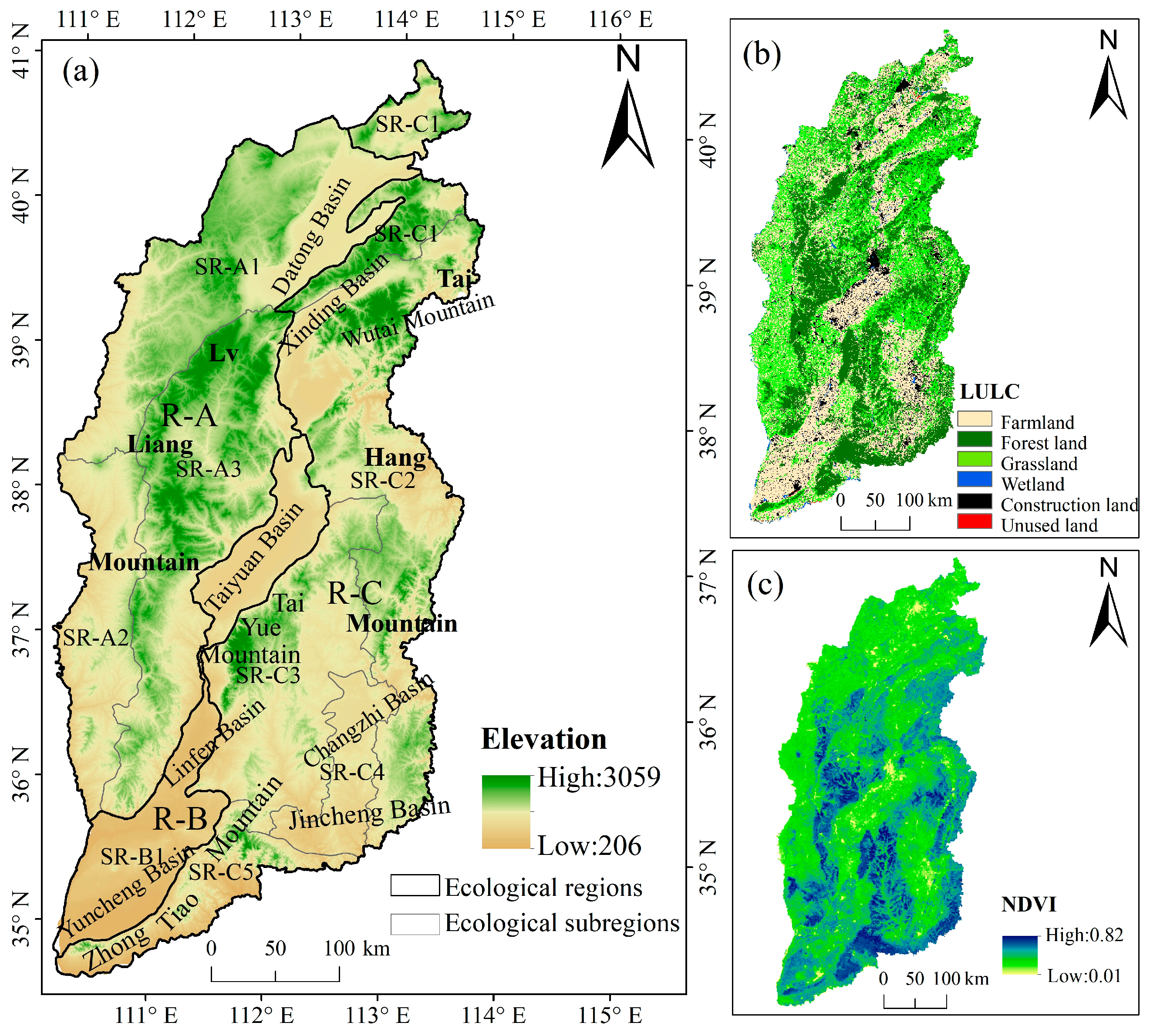
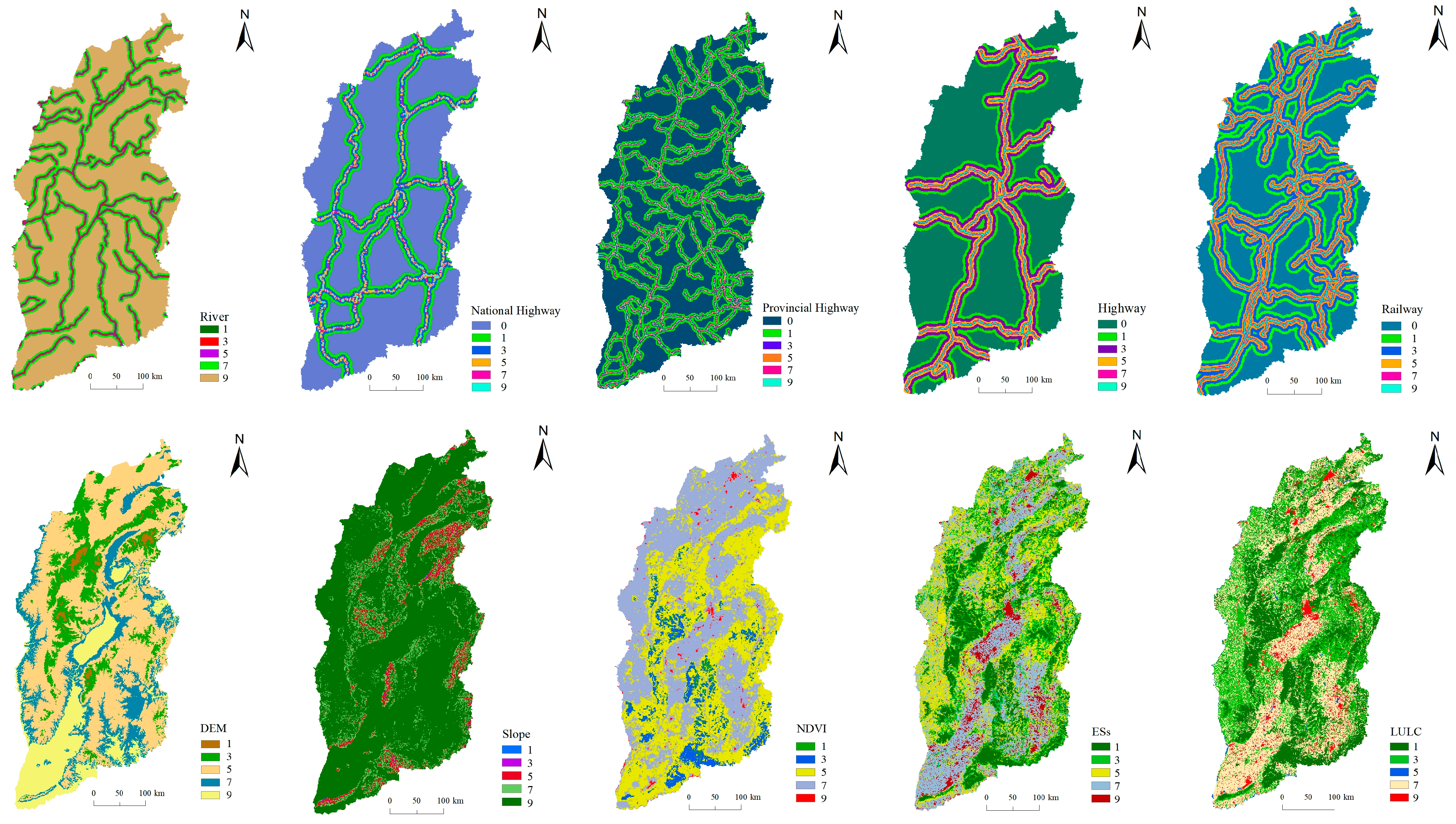
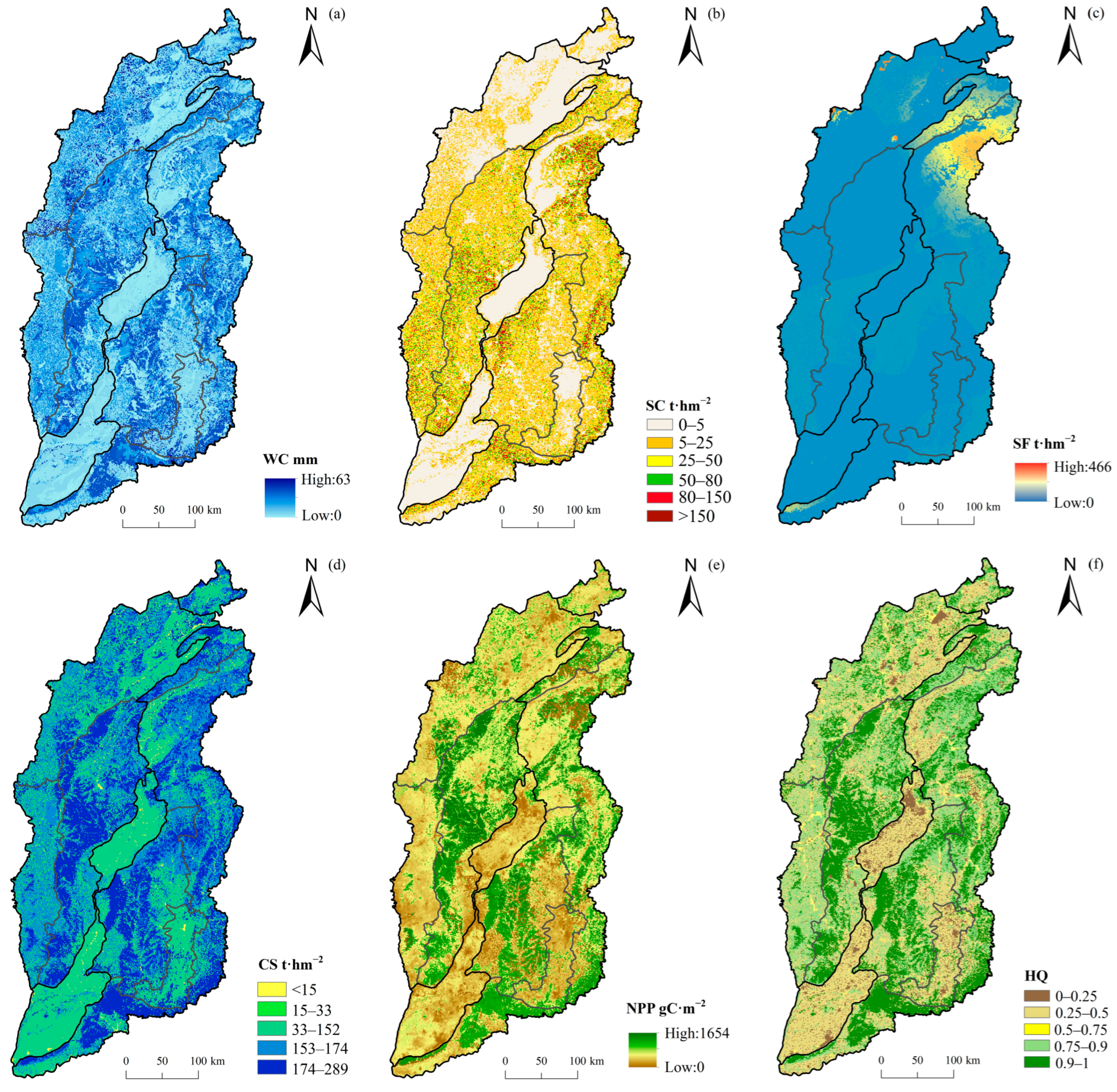
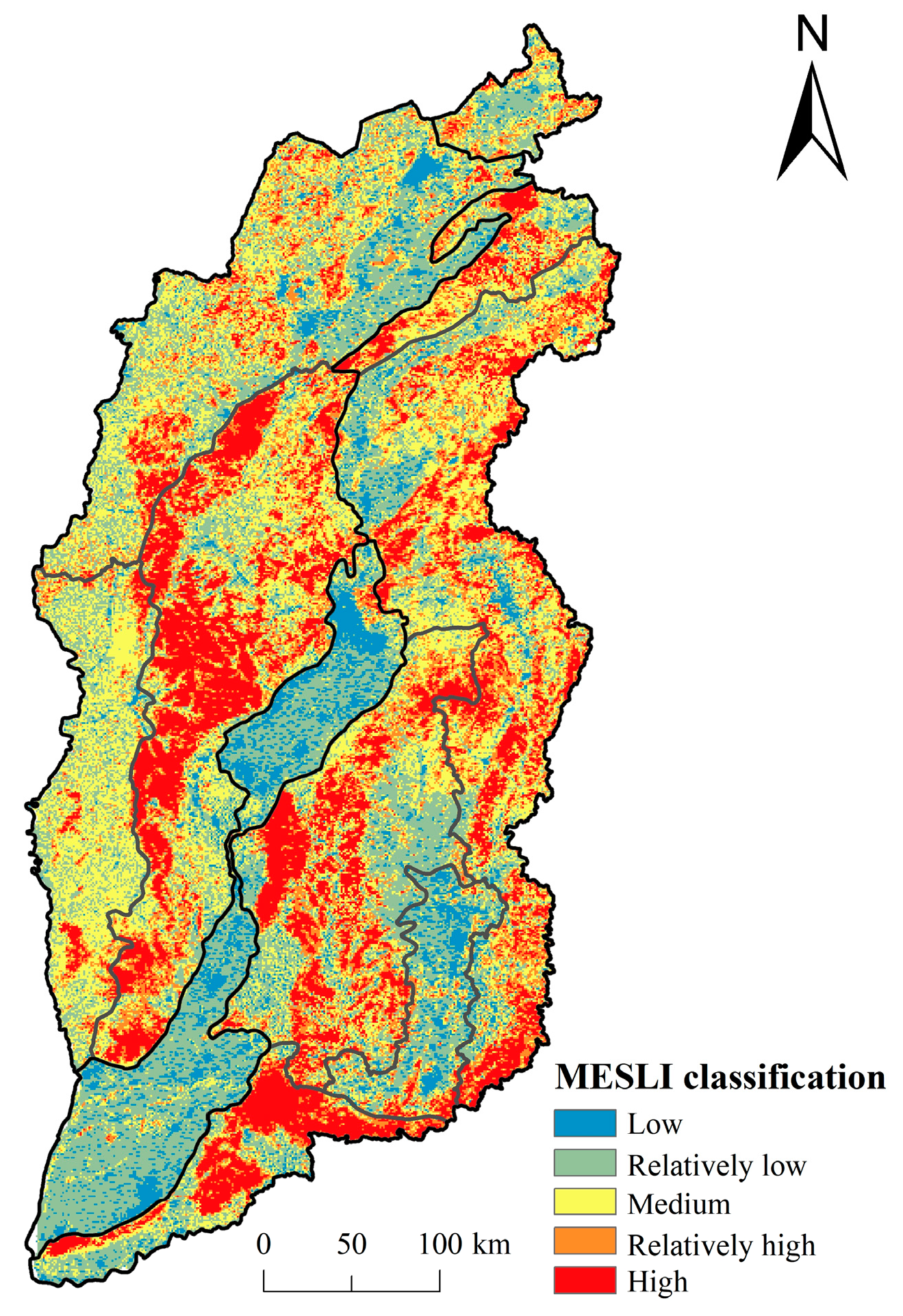

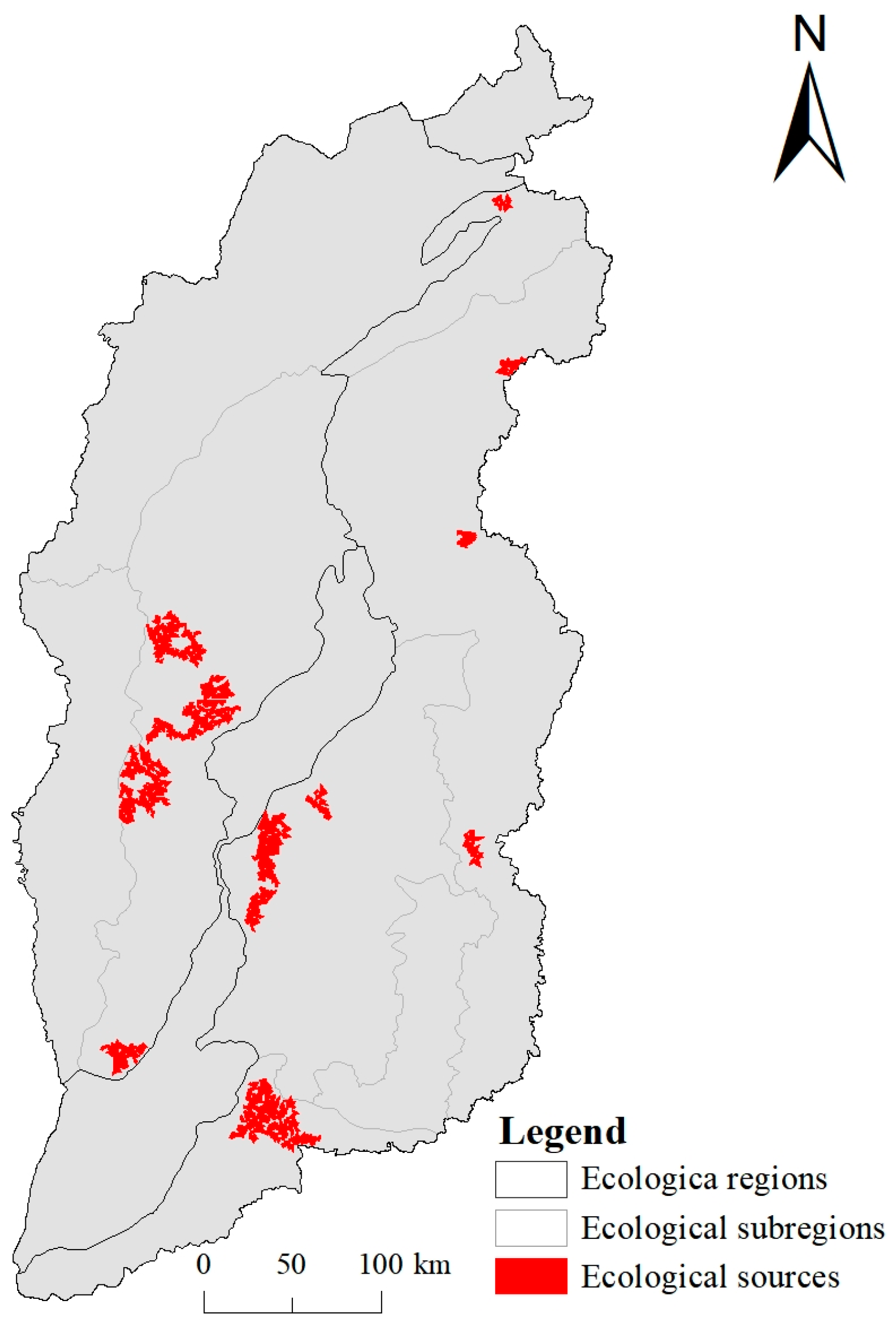
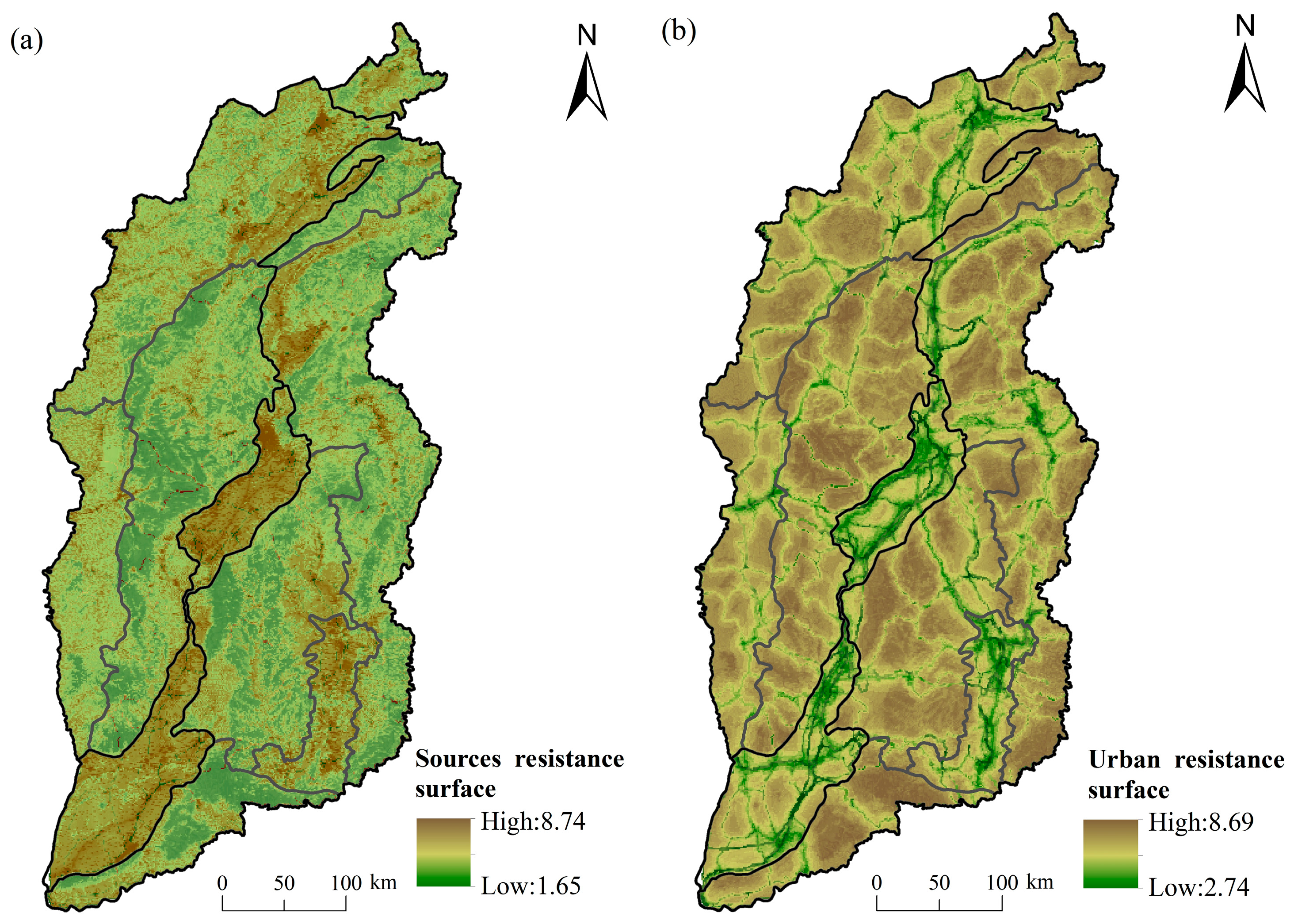
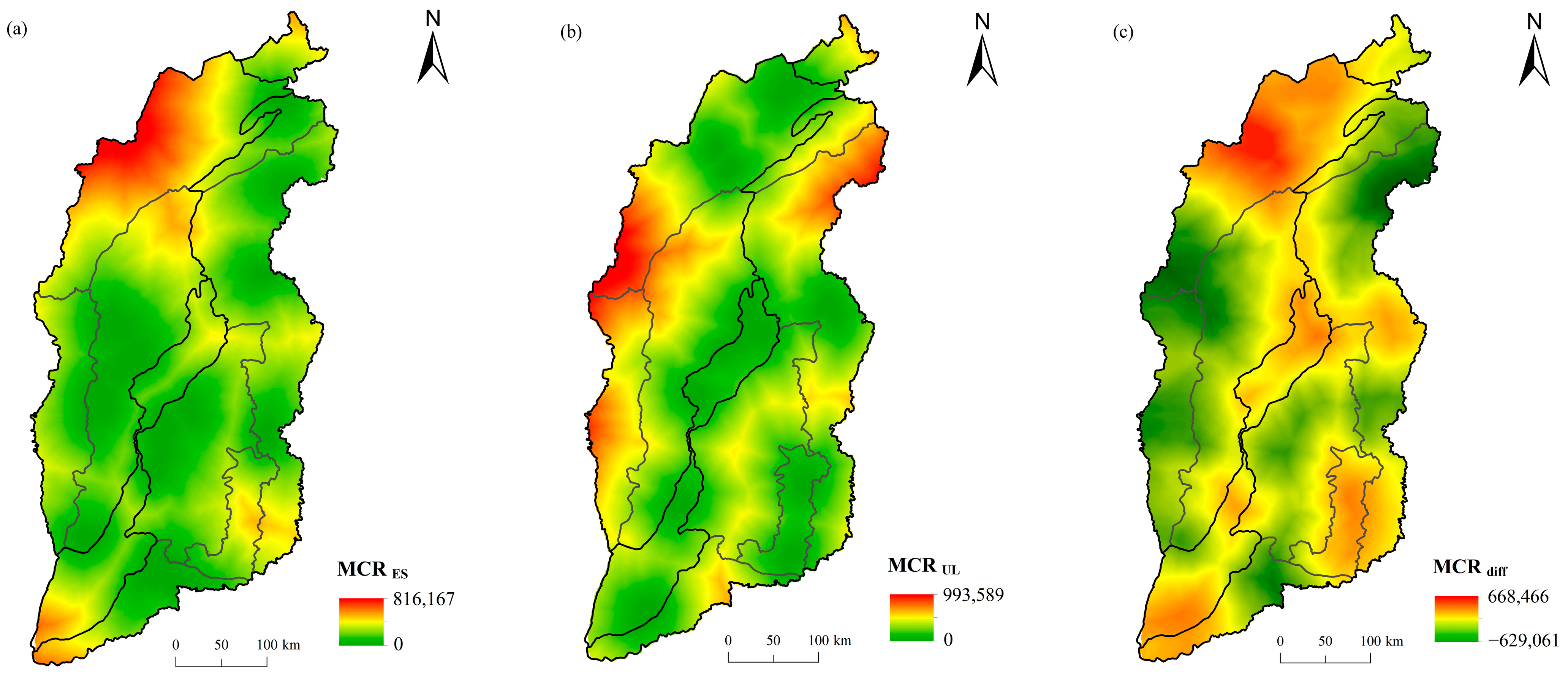
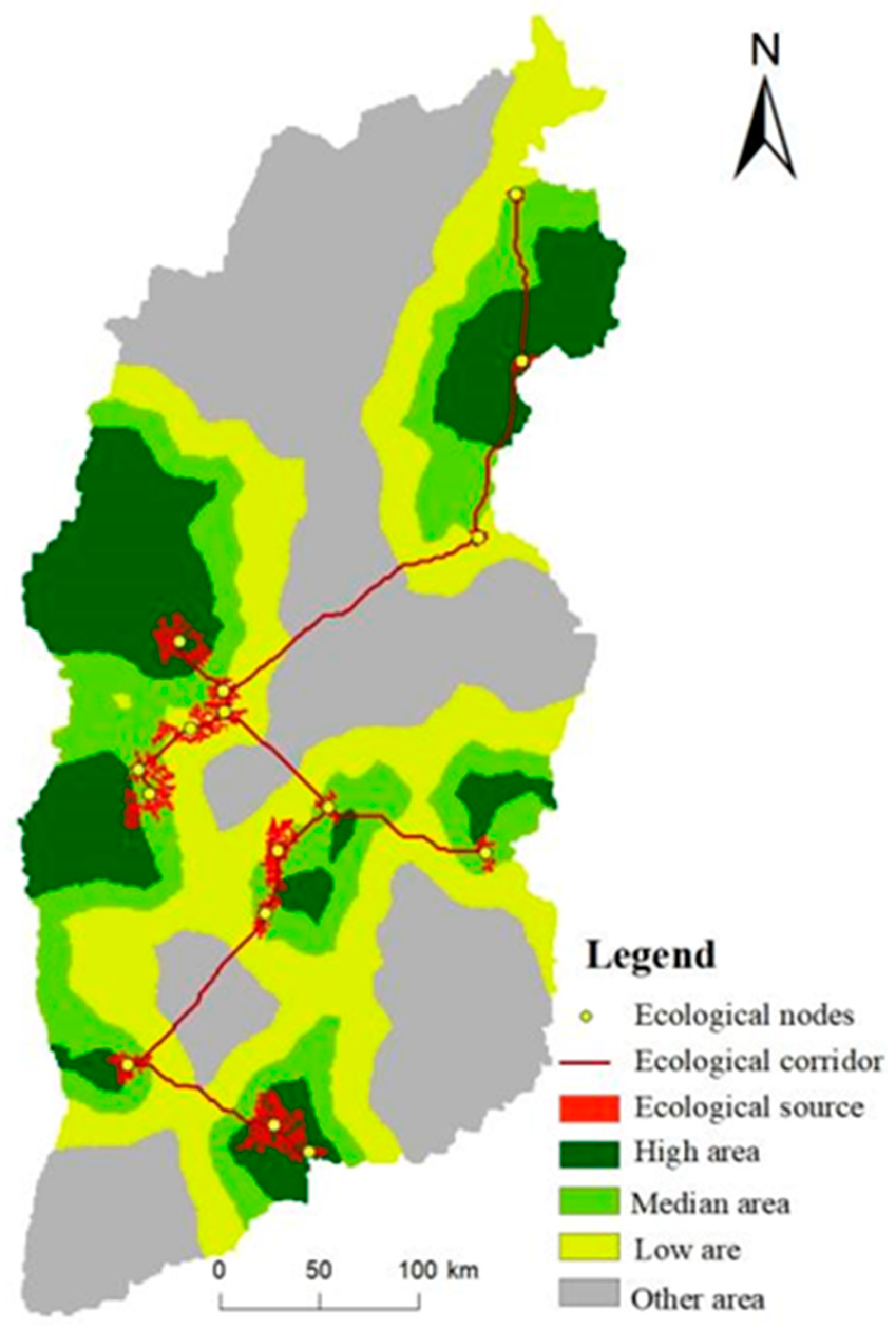
| Ecological Regions | Ecological Subregions | ||
|---|---|---|---|
| R-A | Loess Plateau agricultural and grassland ecological region | SR-A1 | Northern Shanxi mountains and hills semi-arid grassland ecological subregion |
| SR-A2 | South central parts of Northern Shaanxi-Western Shanxi loess hills and gullies ecological subregion | ||
| SR-A3 | Lvliang Mountain deciduous broad-leaf forest ecological subregion | ||
| R-B | Fenwei River Basin agro-ecological region | SR-B1 | Fen River Valley agro-ecological subregion |
| R-C | Yanshan-Taihang Mountains deciduous broad-leaved forest ecological region | SR-C1 | Yongding River upper intermountain basin forest, agriculture and grass ecological subregion |
| SR-C2 | Taihang Mountain deciduous broad-leaved forest ecological subregion | ||
| SR-C3 | Taiyue Mountain Hilly deciduous broad-leaf forest ecological subregion | ||
| SR-C4 | Taihang Mountain and Taiyue Mountain inter-mountain basin hilly agro-ecological subregion | ||
| SR-C5 | Zhongtiao Mountain Hill deciduous broad-leaf forest ecological subregion |
| ESs | Model | Model Descriptions | References |
|---|---|---|---|
| WC | InVEST (Water Yield) | Water yield is calculated based on the balance equation of water quantity, and WC can be calculated by combining water yield with runoff coefficient, terrain index, and soil saturated hydraulic conductivity. | [40] |
| SC | InVEST (Sediment Delivery and Retention) | Including two parts: soil erosion reduction and sediment retention. The former is the difference between potential and actual soil erosion (soil erosions are calculated by the modified soil loss equation), and the latter is the product of sediment and sediment retention rate. | [41,42] |
| SF | National Wind Erosion Survey Model of China (NWESMC) | SF is the difference between potential and actual soil wind erosion, and the soil wind erosion is estimated by the NWESMC. This model is developed for grassland (forest land), sandy land and farmland, and the parameters are calibrated by the wind tunnel experiments on chestnut-calcium soils and wind-sand soils in a typical semi-arid grassland region of China. | [43] |
| CS | InVEST (Carbon) | Total CS is the sum of average carbon density of above-ground carbon pool, below-ground carbon pool, and soil carbon pool for different land use types. | [44,45] |
| NPP | Carnegie Ames Stanford Approach (CASA) | NPP of vegetation is estimated by multiplying absorption photosynthetically active radiation and light energy utilization rate absorbed by vegetation. | [46] |
| HQ | InVEST (Habitat Quality) | HQ is assessed according to the impact distance and spatial weighting of threat sources, habitat suitability and its sensitivity to threat sources, and access for legal protection. | [47,48] |
| Land Use Type | WC/mm | SC/t·hm−2 | SF/t·hm−2 | CS/t·hm−2 | NPP/gC·m−2 | HQ |
|---|---|---|---|---|---|---|
| Farmland | 10.10 | 12.42 | 1.059 | 140.3 | 507.5 | 0.4940 |
| Forest land | 19.35 | 34.93 | 4.698 | 289.3 | 1029 | 0.8374 |
| Grassland | 14.12 | 23.11 | 6.541 | 153.3 | 466.5 | 0.6831 |
| Wet land | 7.540 | 14.45 | 2.071 | 0.000 | 451.5 | 0.5630 |
| Construction land | 9.379 | 8.135 | 1.022 | 66.90 | 417.6 | 0.3315 |
| Unused land | 9.386 | 11.68 | 4.014 | 27.10 | 488.5 | 0.4646 |
| Ecological Regions | Ecological Subregions | WC/mm | SC/t·hm−2 | SF/t·hm−2 | CS/t·hm−2 | NPP/gC·m−2 | HQ |
|---|---|---|---|---|---|---|---|
| R-A | SR-A1 | 13.05 | 5.018 | 1.912 | 165.6 | 560.3 | 0.5726 |
| SR-A2 | 13.43 | 33.16 | 0.5763 | 161.5 | 522.2 | 0.6532 | |
| SR-A3 | 17.00 | 31.32 | 0.4279 | 210.1 | 832.5 | 0.7605 | |
| R-B | SR-B1 | 5.547 | 4.525 | 0.1123 | 130.9 | 439.0 | 0.3378 |
| R-C | SR-C1 | 14.09 | 16.82 | 13.97 | 186.0 | 615.1 | 0.6917 |
| SR-C2 | 14.79 | 30.31 | 11.81 | 187.5 | 695.0 | 0.6941 | |
| SR-C3 | 15.63 | 23.63 | 0.7703 | 199.7 | 651.4 | 0.7145 | |
| SR-C4 | 10.47 | 11.35 | 0.3294 | 157.7 | 483.7 | 0.4313 | |
| SR-C5 | 17.84 | 34.41 | 1.471 | 210.7 | 736.2 | 0.7316 |
Disclaimer/Publisher’s Note: The statements, opinions and data contained in all publications are solely those of the individual author(s) and contributor(s) and not of MDPI and/or the editor(s). MDPI and/or the editor(s) disclaim responsibility for any injury to people or property resulting from any ideas, methods, instructions or products referred to in the content. |
© 2023 by the authors. Licensee MDPI, Basel, Switzerland. This article is an open access article distributed under the terms and conditions of the Creative Commons Attribution (CC BY) license (https://creativecommons.org/licenses/by/4.0/).
Share and Cite
Wang, J.; Li, Y.; Wang, S.; Li, Q.; Li, L.; Liu, X. Assessment of Multiple Ecosystem Services and Ecological Security Pattern in Shanxi Province, China. Int. J. Environ. Res. Public Health 2023, 20, 4819. https://doi.org/10.3390/ijerph20064819
Wang J, Li Y, Wang S, Li Q, Li L, Liu X. Assessment of Multiple Ecosystem Services and Ecological Security Pattern in Shanxi Province, China. International Journal of Environmental Research and Public Health. 2023; 20(6):4819. https://doi.org/10.3390/ijerph20064819
Chicago/Turabian StyleWang, Jinfeng, Ya Li, Sheng Wang, Qing Li, Lingfeng Li, and Xiaoling Liu. 2023. "Assessment of Multiple Ecosystem Services and Ecological Security Pattern in Shanxi Province, China" International Journal of Environmental Research and Public Health 20, no. 6: 4819. https://doi.org/10.3390/ijerph20064819
APA StyleWang, J., Li, Y., Wang, S., Li, Q., Li, L., & Liu, X. (2023). Assessment of Multiple Ecosystem Services and Ecological Security Pattern in Shanxi Province, China. International Journal of Environmental Research and Public Health, 20(6), 4819. https://doi.org/10.3390/ijerph20064819





